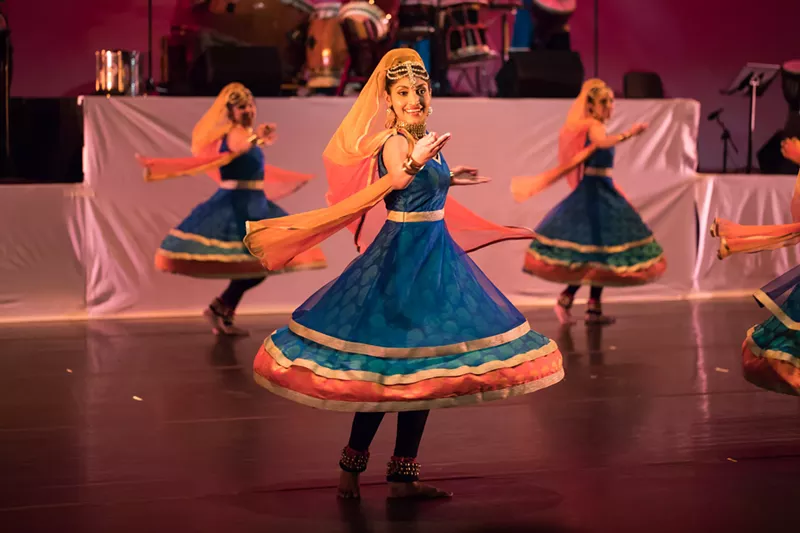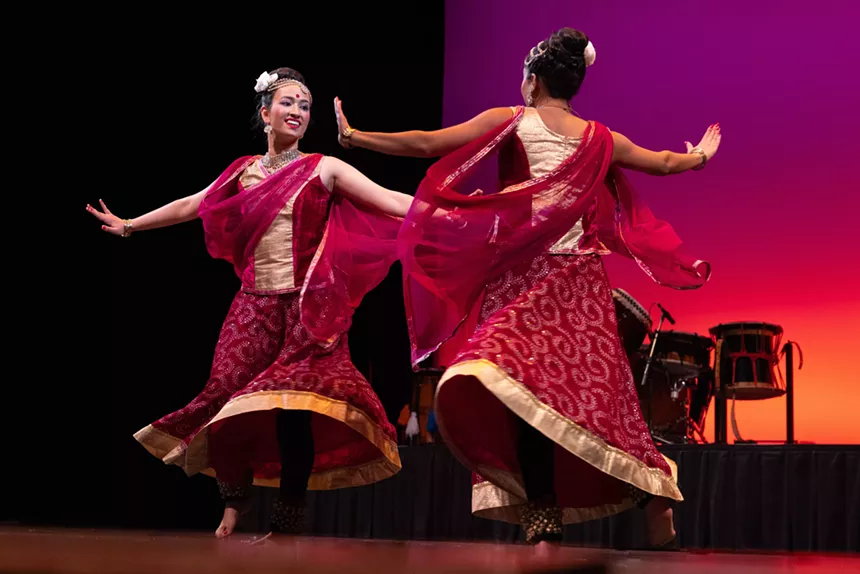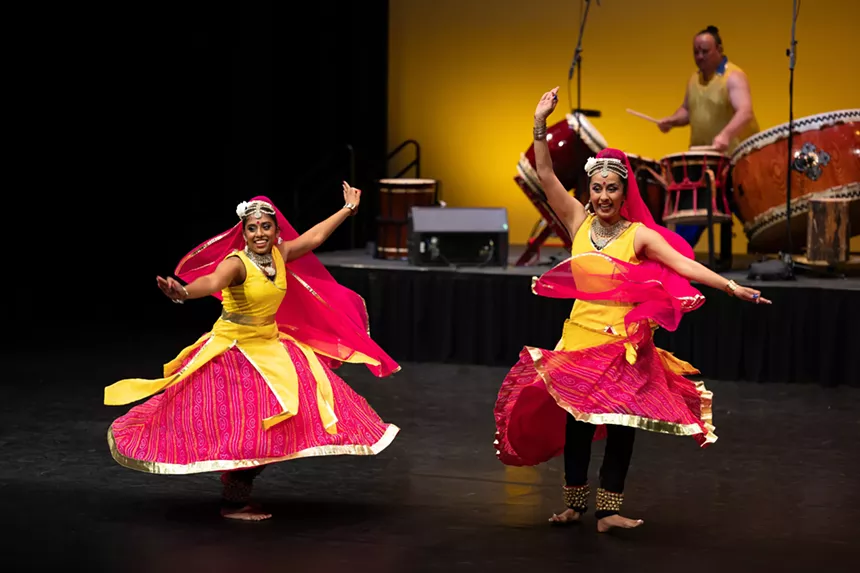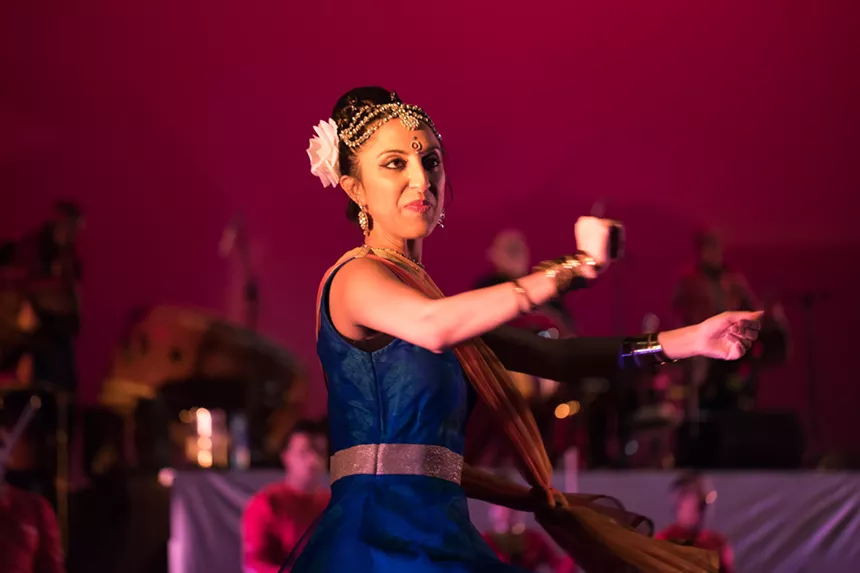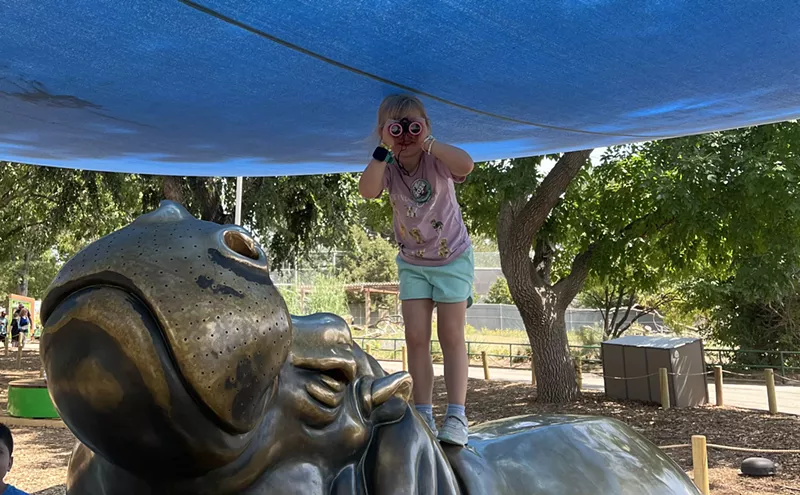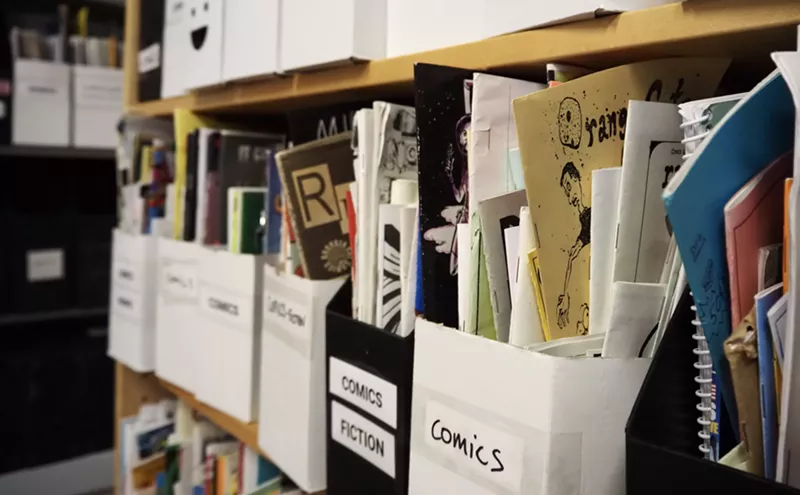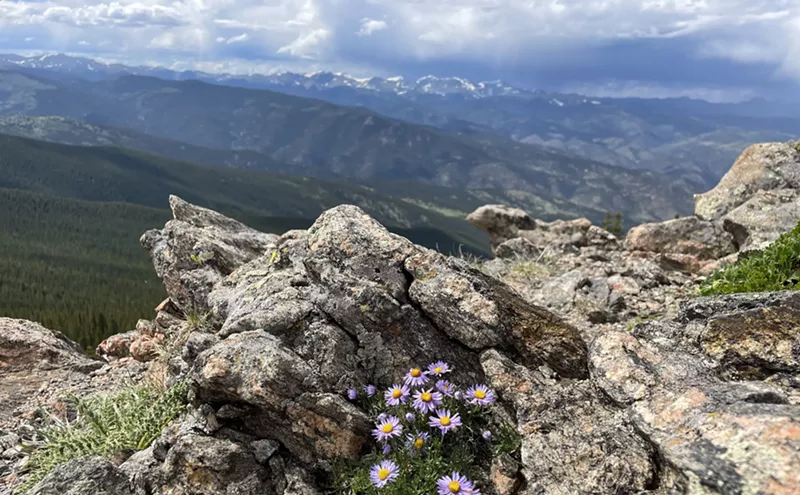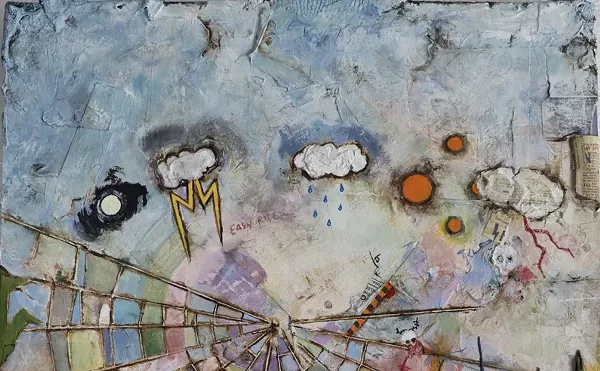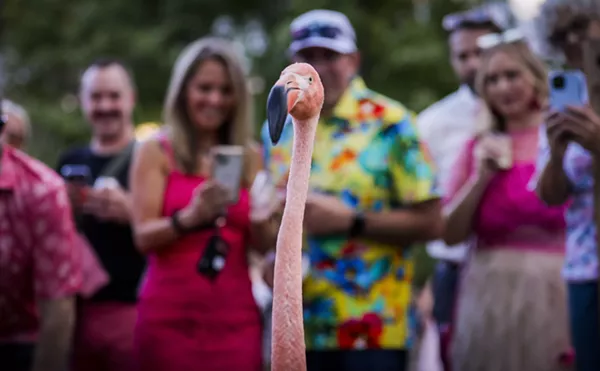When Adyananta takes the stage at the Lakewood Cultural Center from August 21 to 24, audiences will witness the world premiere of a dance show that has been in the works for over five years. Presented by Denver's Mudra Dance Studio, the show has been one of the company's most difficult and rewarding projects.
"It's been an ambitious project, and we're really proud of it," says Mudra founder and creative director Namita Khanna Nariani, who co-produced the show with music director Aaron Templer. "2019 is when we started talking about this idea, and we were going to try to put it up in 2021, and everything just kind of fell apart at that point. The art world was devastated by COVID-19, and we are so lucky that we stayed in business."
When the project finally returned to life, Nariani and music director Aaron Templer, a longtime collaborator with the company, set out to create a work that would explore a single, universal theme: endings. Templer was drawn to the idea of how art could help audiences approach them with more intention.
"As a society, we're sort of transfixed with fixing things and trying to prevent endings," Templer says. "But really, what the rhythms of our humanity teach us is that if you go through an ending intentionally, including the very uncomfortable, maybe even sad, negative parts of it, you'll come out the other end transformed. Artists contemplate endings in all kinds of interesting ways and can help us think about how we, as humans, need to be present in our own endings."
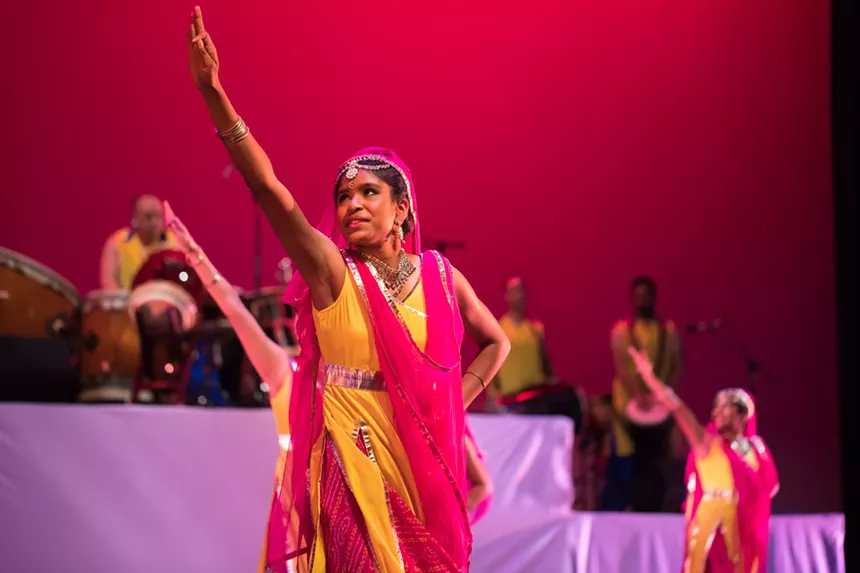 To bring that vision to the stage, the team has shaped Adyananta, the Sanskrit term for “that with no beginning or end,” into Mudra's ninth production show. The choreography is rooted in Kathak, a North Indian classical form known for intricate footwork and storytelling, but expands into Bharatanatyam, Samba, Jazz, and other global styles. For Nariani, that evolution mirrors the interconnected world she sees both in and beyond the studio.
To bring that vision to the stage, the team has shaped Adyananta, the Sanskrit term for “that with no beginning or end,” into Mudra's ninth production show. The choreography is rooted in Kathak, a North Indian classical form known for intricate footwork and storytelling, but expands into Bharatanatyam, Samba, Jazz, and other global styles. For Nariani, that evolution mirrors the interconnected world she sees both in and beyond the studio.
"This world is not cookie-cutter," Nariani says. "I am a very devoted Kathak dancer and Kathak is our foundation, but everything evolves, and as individuals, evolving is important for growth. For me, dance has the same effect, and I've tried to instill that learning process in my students by teaching them that the world is an amalgamation, a harmony of all these individuals and cultures, which you'll see reflected in the dances."
To capture the theme musically, Templer turned to award-winning composer Akash Mittal, whose work pushes the boundaries between Eastern and Western traditions. The commissioned score blends traditional Indian rhythms with unexpected elements, such as Japanese taiko drums providing the pulse of the piece.
“It’s really unusual for a dance studio, let alone in Colorado, to commission original music,” Templer says. “It’s a real source of pride for the Colorado arts community that we're having this kind of world premiere."
That commitment to originality extends beyond the music. Spoken word artist Dominique Christina will appear at pivotal moments in the show, her poetry acting as connective tissue between scenes and guiding audiences deeper into the emotional arc. Lighting, projections and set elements are designed to heighten the experience, while the musicians perform onstage alongside the dancers, making them an active part of the visual landscape.
“We’re doing things with staging to try to break down that wall between audience and performers,” Templer says. “This is engaging, high-energy and super emotional.”
The return to the project after its long pandemic delay demanded resourcefulness. “These shows aren’t cheap,” Nariani says. “At Mudra, we want to give an audience member who spends even a dollar to come and watch us the best possible experience, and that costs money. We were lucky to be able to put this together with the support we received.”
It also took months of intense preparation. Dancers rehearsed three times a week, with long Sunday sessions devoted to refining choreography, syncing movement to live music and adjusting to the show’s complex staging.
“When you put on professional-level shows like this, people think of it as a recital for a dance studio, and it’s not,” Templer says. “It involves original staging, original rigging, original lighting, and, of course, newly commissioned music with professional musicians. The dancers have been working for six to eight months, three days a week, including four hours on Sunday, so those logistics are challenging, but so far, it's coming together pretty well."
"This has been a work of passion in the way of each and every dancer," Nariani adds. "We're all volunteers in the studio, so everybody's dedicating their time because they want to, not because they're being paid for it. The musicians are at the pro level, and they're getting paid, but all us dancers are in it for the sheer love for this project."
The payoff, according to Nariani, comes when audiences feel welcomed into the work, not just as spectators, but as participants in their own way. Costumes, handcrafted in India and designed to move with the dancers, add bursts of color and texture that respond dynamically to every gesture and turn. Projections and lighting shifts mirror the emotional shifts in the music and choreography.
“When Mudra enters a space, you feel that you’re welcome in our art,” Nariani says. “Not just as an audience member, but as someone who can connect to it, whether through the rhythm, the visuals, or the emotions behind it.”
Both Nariani and Templer see Adyananta as a statement about the importance of supporting new art. “I’d like people to walk away thinking, ‘I’m really glad I experienced original art,’” Templer says. “This isn’t another Nutcracker. This is somebody with a vision and a wholly original concept."
And for anyone in the audience navigating their own endings, whether the loss of a loved one, a life transition or a shift in identity, the show offers a reminder that they are not alone.
“Depending on where you are and what stage of life you are in, you are going to be thinking about your endings and the new beginnings in different ways,” Nariani says. “We’re not dictating anything to the audience. We’re letting them take this journey on pathways that they create themselves. We’re just facilitating that for them.”
Adyananta runs from Thursday, August 21, through Sunday, August 24, at the Lakewood Cultural Center, 470 South Allison Parkway, Civic Center North Building. Tickets are $40. Learn more at mudra2025.org.
"It's been an ambitious project, and we're really proud of it," says Mudra founder and creative director Namita Khanna Nariani, who co-produced the show with music director Aaron Templer. "2019 is when we started talking about this idea, and we were going to try to put it up in 2021, and everything just kind of fell apart at that point. The art world was devastated by COVID-19, and we are so lucky that we stayed in business."
When the project finally returned to life, Nariani and music director Aaron Templer, a longtime collaborator with the company, set out to create a work that would explore a single, universal theme: endings. Templer was drawn to the idea of how art could help audiences approach them with more intention.
"As a society, we're sort of transfixed with fixing things and trying to prevent endings," Templer says. "But really, what the rhythms of our humanity teach us is that if you go through an ending intentionally, including the very uncomfortable, maybe even sad, negative parts of it, you'll come out the other end transformed. Artists contemplate endings in all kinds of interesting ways and can help us think about how we, as humans, need to be present in our own endings."

Mudra Dance Studio's ninth production show is titled Adyananta, which means "that without beginning or end" in Sanskrit.
Courtesy of Shawn Herbert Photography
"This world is not cookie-cutter," Nariani says. "I am a very devoted Kathak dancer and Kathak is our foundation, but everything evolves, and as individuals, evolving is important for growth. For me, dance has the same effect, and I've tried to instill that learning process in my students by teaching them that the world is an amalgamation, a harmony of all these individuals and cultures, which you'll see reflected in the dances."
To capture the theme musically, Templer turned to award-winning composer Akash Mittal, whose work pushes the boundaries between Eastern and Western traditions. The commissioned score blends traditional Indian rhythms with unexpected elements, such as Japanese taiko drums providing the pulse of the piece.
“It’s really unusual for a dance studio, let alone in Colorado, to commission original music,” Templer says. “It’s a real source of pride for the Colorado arts community that we're having this kind of world premiere."
That commitment to originality extends beyond the music. Spoken word artist Dominique Christina will appear at pivotal moments in the show, her poetry acting as connective tissue between scenes and guiding audiences deeper into the emotional arc. Lighting, projections and set elements are designed to heighten the experience, while the musicians perform onstage alongside the dancers, making them an active part of the visual landscape.
“We’re doing things with staging to try to break down that wall between audience and performers,” Templer says. “This is engaging, high-energy and super emotional.”
The return to the project after its long pandemic delay demanded resourcefulness. “These shows aren’t cheap,” Nariani says. “At Mudra, we want to give an audience member who spends even a dollar to come and watch us the best possible experience, and that costs money. We were lucky to be able to put this together with the support we received.”
It also took months of intense preparation. Dancers rehearsed three times a week, with long Sunday sessions devoted to refining choreography, syncing movement to live music and adjusting to the show’s complex staging.
“When you put on professional-level shows like this, people think of it as a recital for a dance studio, and it’s not,” Templer says. “It involves original staging, original rigging, original lighting, and, of course, newly commissioned music with professional musicians. The dancers have been working for six to eight months, three days a week, including four hours on Sunday, so those logistics are challenging, but so far, it's coming together pretty well."
"This has been a work of passion in the way of each and every dancer," Nariani adds. "We're all volunteers in the studio, so everybody's dedicating their time because they want to, not because they're being paid for it. The musicians are at the pro level, and they're getting paid, but all us dancers are in it for the sheer love for this project."
The payoff, according to Nariani, comes when audiences feel welcomed into the work, not just as spectators, but as participants in their own way. Costumes, handcrafted in India and designed to move with the dancers, add bursts of color and texture that respond dynamically to every gesture and turn. Projections and lighting shifts mirror the emotional shifts in the music and choreography.
“When Mudra enters a space, you feel that you’re welcome in our art,” Nariani says. “Not just as an audience member, but as someone who can connect to it, whether through the rhythm, the visuals, or the emotions behind it.”
Both Nariani and Templer see Adyananta as a statement about the importance of supporting new art. “I’d like people to walk away thinking, ‘I’m really glad I experienced original art,’” Templer says. “This isn’t another Nutcracker. This is somebody with a vision and a wholly original concept."
And for anyone in the audience navigating their own endings, whether the loss of a loved one, a life transition or a shift in identity, the show offers a reminder that they are not alone.
“Depending on where you are and what stage of life you are in, you are going to be thinking about your endings and the new beginnings in different ways,” Nariani says. “We’re not dictating anything to the audience. We’re letting them take this journey on pathways that they create themselves. We’re just facilitating that for them.”
Adyananta runs from Thursday, August 21, through Sunday, August 24, at the Lakewood Cultural Center, 470 South Allison Parkway, Civic Center North Building. Tickets are $40. Learn more at mudra2025.org.

